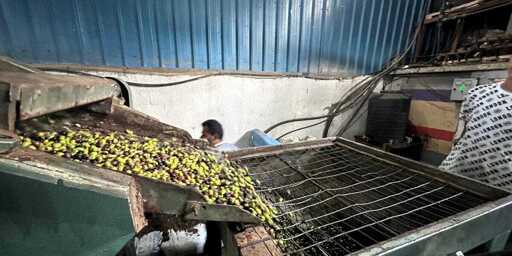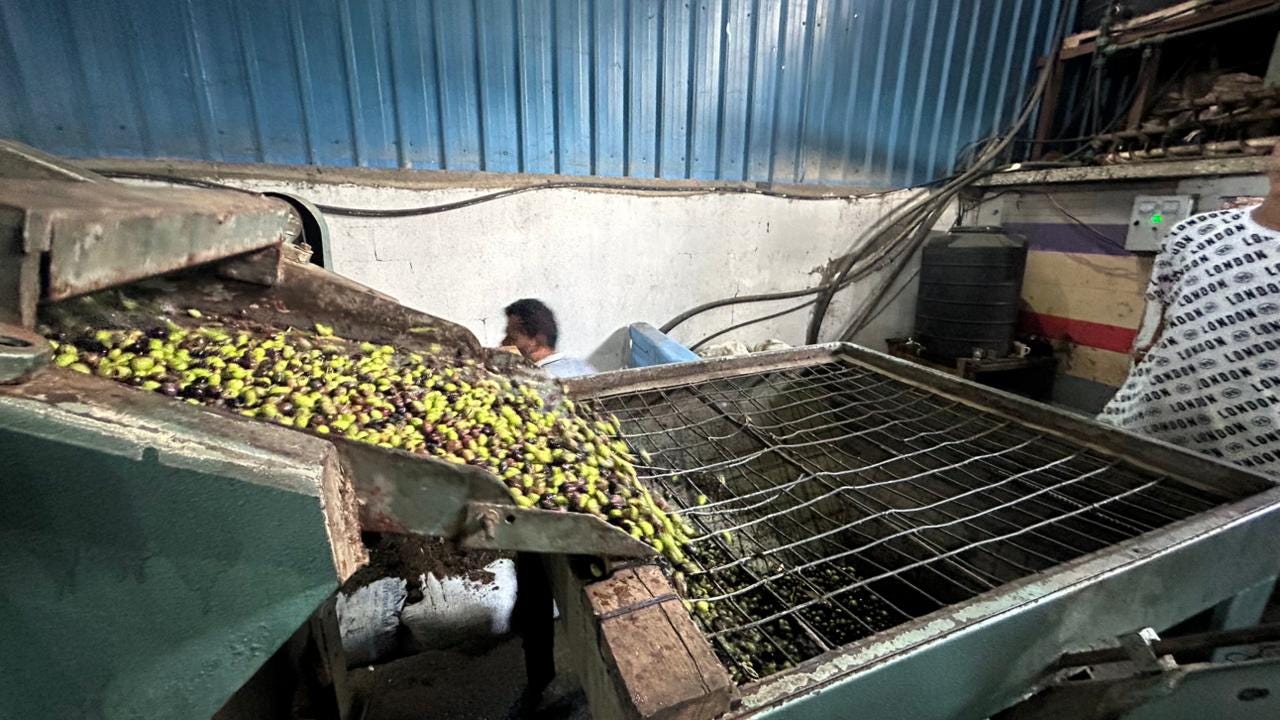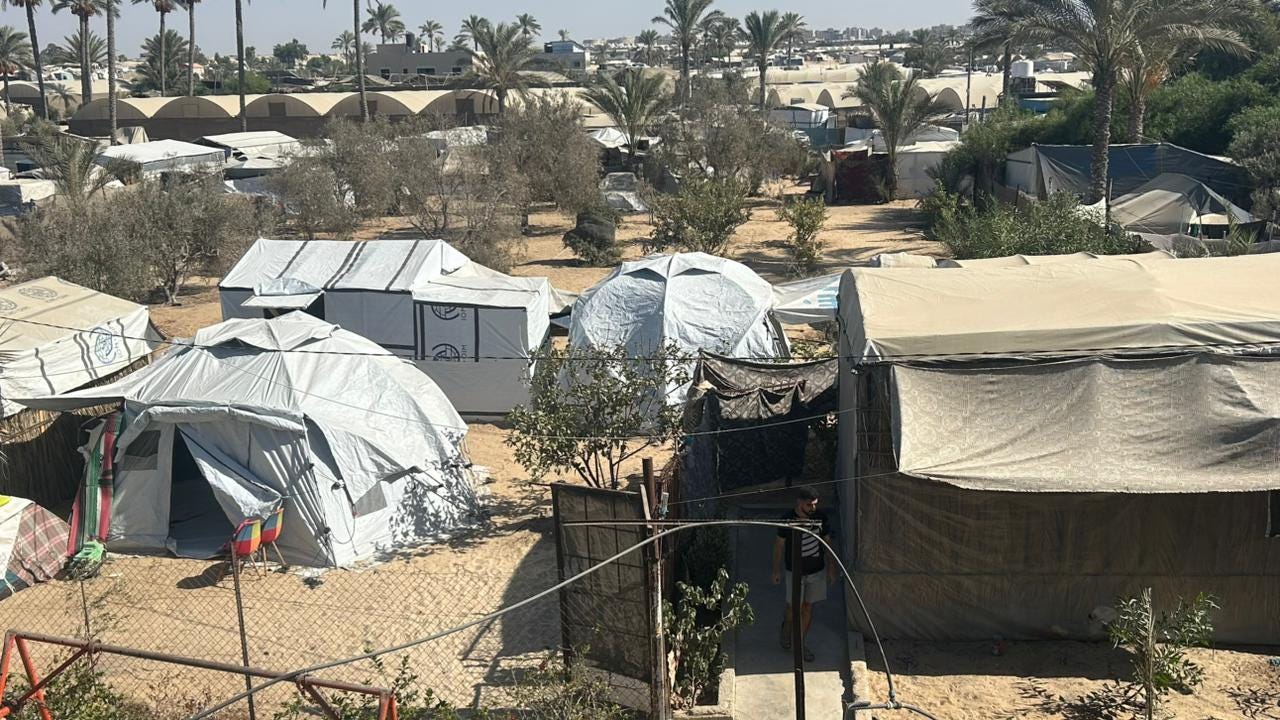On Sunday, the first day of the olive harvest in the village of Turmus’ayyer, near Ramallah in the occupied West Bank, a group of Israeli settlers attacked Palestinians farmers and residents in a brutal assault that left many people injured, including a Palestinian women who was knocked unconscious with a club. The incident was captured on video by journalist Jasper Nathaniel who said Israeli soldiers in the area led a group of Palestinian famers “directly into a brutal ambush by armed settlers.”
Drop Site spoke to Nathaniel about what happened. You can listen to the interview here.
In Gaza, Palestinian farmers are missing their third consecutive olive harvest as Israel’s war on the enclave has all but decimated Gaza’s olive groves. Gaza-based journalist Mohamed Suleiman spoke to olive farmers and agricultural experts to report on the state of olives and the olive oil industry in Gaza two years into the war and as a fragile “ceasefire” has taken hold.
We have a commitment to ensuring that our journalism is not locked behind a paywall. But the only way we can sustain this is through the voluntary support of our community of readers. If you are a free subscriber and you support our work, please consider upgrading to a paid subscription or gifting one to a friend or family member.
— Sharif Abdel Kouddous
The Abu Zidan olive press in central Gaza, one of the few olive presses still functioning in the enclave. October 9, 2025. (Photo by Mohamed Suleiman.)
Story by Mohamed Suleiman
AL-MAWASI KHAN YOUNIS, GAZA STRIP—The last time Hajj Suleiman Abdel-Nabi witnessed a normal olive harvest was three years ago.
Days before the “ceasefire” went into effect on October 10, the 75-year-old farmer took a saw to what remains of his three-dunam (about three quarters of an acre) olive farm in southern Gaza’s Al-Mawasi area. Alongside the massive destruction of homes and civilian infrastructure wrought by Israel’s two-year war on Gaza, the toll on agriculture and farmland in the enclave has been equally devastating. With Gaza’s water resources severely depleted, half of Abdel-Nabi’s olive trees have dried up and died.
“Water became more precious than gold,” he says. “How can I ask for water for trees when people are dying of thirst?”
Israel’s war on Gaza that began in October 2023—at the height of the olive harvest—all but stopped in the same season with last week’s “ceasefire.” Over the past two years, nearly 68,000 Palestinians have been confirmed killed, in what is widely acknowledged to be a vast undercount, and entire cities and towns have been reduced to rubble. Israel’s siege and starvation campaign triggered a famine across much of the enclave. Despite the genocidal assault that devastated their crops and sent costs skyrocketing, Palestinian farmers in Gaza were still preparing for the olive harvest, even though there are barely any olives left to pick.
“The olive trees have become firewood now,” he said bitterly. “I feel pain with every cut—not just for the loss, but because these trees are life itself. For Palestinians, they are a symbol of steadfastness. When they die, it feels like another disaster.”
Abdel-Nabi’s son, also named Suleiman, helped his father cut the dead tree trunks, hoping to save the few trees that still showed faint signs of life. A neighboring farmer recently installed a solar-powered well—one of the only ways to draw groundwater after Gaza’s power grid was targeted in the first days of the war—and Abdel-Nabi hoped to borrow some water to revive whatever trees he could.
An August assessment, based on satellite data from the Food and Agriculture Organization of the United Nations and the United Nations Satellite Centre, found that 98.5 percent of cropland in the Gaza Strip is either damaged, inaccessible, or both. “This means that only 1.5 percent of cropland in Gaza—232 hectares—is currently available for cultivation, down from 4.6 percent (688 hectares) as of April 2025, in a territory with over 2 million people,” the report said.
“Most of the trees are gone,” Mohammed Abu Odeh, an agricultural expert in the horticulture sector, told Drop Site. “But some farmers are risking their lives to pick what remains.”
“The olive harvest is central to life in Gaza,” he added. “More than 10,000 families depend on it, and olive oil is part of every meal. But with production collapsing and aid restricted, even a few liters of oil have become treasures.” Today, a single liter of olive oil sells for about 100 shekels (about $30)—nearly double last year’s price. “It’s almost impossible to find,” Abu Odeh said.
Abdel-Nabi, a father of 12 children and grandfather of 35, used to harvest more than 35 gallons of olive oil each year—about half from Al-Mawasi and half from two dunams (about half an acre) of century-old trees in Khan Younis. The trees in Al-Mawasi have not been irrigated or fertilized since the beginning war, leaving all the trees dry and dead, save for a handful he is trying to revive. In Khan Younis, the Israeli military bulldozed his entire orchard.
Hajj Suleiman Abdel-Nabi’s olive farm in Al-Mawasi, Khan Younis, has gone dry from a lack of water as a result of the war. October 9, 2025. (Photo by Mohamed Suleiman.)
With no harvest, Abdel-Nabi now has to buy olives and olive oil instead of selling them. “This year, I buy the same olives and oil I once sold,” he says. “I used to sell a kilo of olives for two dollars—now I buy them for ten. A liter of olive oil that once cost $10 now costs for $25.”
He wipes away tears as he looks over the stumps. “The olive season was our happiest time of year,” he said. “We would gather to pick, sing, and eat together. Now that joy is gone—like everything else this war has taken.”
In central Gaza, 21-year-old Ahmed al-Adini arrived at a small olive press on Salah al-Din Road. Al-Adini is recently married and his wife is expecting their first child this month. His olive harvest barely yielded 170 kilograms this season, down from an average of a ton before the war.
With the help of his father and brothers, he carried sacks of olives by donkey cart to the press. “We could hardly water the trees,” he said. “The land was next to Israeli tank positions for months.”
Still, the family has insisted on harvesting its crops. “For my father, it’s not just oil—it’s identity,” Ahmed said. “We want to taste oil from our own trees, not from somewhere we don’t trust. The olive tree tells us we are still alive.”
A Symbol of Steadfastness
For Palestinians, the olive tree is more than just a crop; it’s a cultural anchor, passed down through generations and woven into memory and resistance. Trapped in a suffocating Israeli siege since 2007, Palestinians in Gaza have long relied on local agriculture as one of the few ways to survive. Now, even that has been stripped away.
At another press, 43-year-old Mohammed Abu Jleidan arrived by bicycle, pushing a small cart with his two sons: 13-year-old Yusuf and 14-year-old Mo’tasem. They brought 270 kilograms of olives from three dunams of land (about three quarters of an acre) that once yielded two tons.
“Given everything—no water, no fertilizer, no care—this small harvest is a blessing,” Abu Jleidan told Drop Site. “Many farmers have lost everything. Their trees dried or were bulldozed. I’m lucky to have even this.”
The cost of pressing oil has multiplied. Before the war, it cost less than half a shekel per kilo. Today, it costs three shekels (about $0.9), driven by soaring prices of diesel, spare parts, and labor.
“Fuel costs $25 a liter now; it used to be less than two,” said Zidan Fawaz Zidan, 54, who owns one of the few presses still running in central Gaza. “We used to process 150 tons of olives a day. Now it’s barely five tons every two days.”
More than 35 presses have been destroyed across Gaza over the past two years. Only five remain operational, all of them in the central region.
According to Fayyad Fayyad, the head of the Palestinian Olive Council, Gaza’s olive sector is “almost completely destroyed.”
“There is no olive season this year,” Fayyad told Drop Site. “We estimate that nearly one million of Gaza’s 1.1 million olive trees have been destroyed.” In 2022, Gaza produced about 50,000 tons of olives. This year, Fayyad said, the total will be well under a thousand. “The destruction is deliberate,” he said. “Israel aims to eliminate the agricultural sector, including olives. What remains are scattered trees—not groves, not production.”
Fayyad’s olive council is preparing a plan to rebuild the olive sector if the ceasefire holds and the war ends—beginning with soil testing to detect contamination from munitions and rebuilding irrigation networks. The government of Tunisia has pledged 180,000 olive saplings to Gaza once conditions allow.
But replanting will take years. “The olive tree is slow to grow,” Fayyad says. “It takes patience—and peace—for it to bear fruit again.”
Despite the devastation, Gaza’s farmers are returning to their olive groves—to water, to prune, to salvage whatever life remains.
“The olive tree is the story of Palestine,” Abdel-Nabi said. “Even when it burns, it still stands in our hearts.”
This piece was published in collaboration with Egab.
From Drop Site News via this RSS feed




